The Cambridge History of Japan, Vol. 1: Ancient Japan
Подождите немного. Документ загружается.

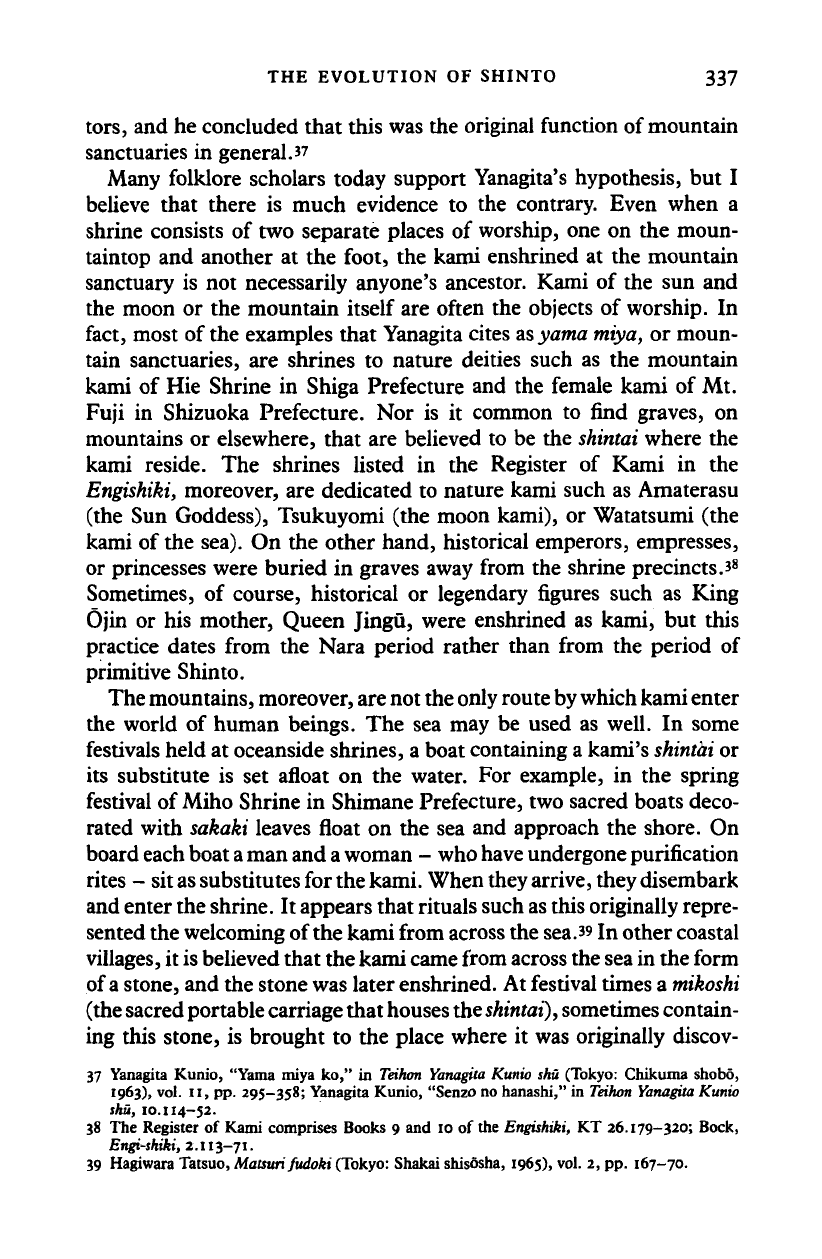
THE EVOLUTION OF SHINTO 337
tors,
and he concluded that this was the original function of mountain
sanctuaries in general."
Many folklore scholars today support Yanagita's hypothesis, but I
believe that there is much evidence to the contrary. Even when a
shrine consists of two separate places of worship, one on the moun-
taintop and another at the foot, the kami enshrined at the mountain
sanctuary is not necessarily anyone's ancestor. Kami of the sun and
the moon or the mountain itself are often the objects of worship. In
fact, most of the examples that Yanagita cites as yama
miya,
or moun-
tain sanctuaries, are shrines to nature deities such as the mountain
kami of Hie Shrine in Shiga Prefecture and the female kami of Mt.
Fuji in Shizuoka Prefecture. Nor is it common to find graves, on
mountains or elsewhere, that are believed to be the
shintai
where the
kami reside. The shrines listed in the Register of Kami in the
Engishiki,
moreover, are dedicated to nature kami such as Amaterasu
(the Sun Goddess), Tsukuyomi (the moon kami), or Watatsumi (the
kami of the sea). On the other hand, historical emperors, empresses,
or princesses were buried in graves away from the shrine precincts.*
8
Sometimes, of course, historical or legendary figures such as King
Ojin or his mother, Queen Jingu, were enshrined as kami, but this
practice dates from the Nara period rather than from the period of
primitive Shinto.
The mountains, moreover,
are
not
the only
route by which kami enter
the world of human beings. The sea may be used as well. In some
festivals held at oceanside shrines, a boat containing
a
kami's
shintai
or
its substitute is set afloat on the water. For example, in the spring
festival of
Miho
Shrine in Shimane Prefecture, two sacred boats deco-
rated with sakaki leaves float on the sea and approach the shore. On
board each boat
a
man and
a
woman - who
have
undergone purification
rites - sit
as
substitutes for the
kami.
When they
arrive,
they disembark
and enter the
shrine.
It appears that rituals such
as
this originally repre-
sented the welcoming of the kami from across the sea.*
9
In other coastal
villages,
it
is
believed that the kami
came
from across the sea in the form
of a stone, and the stone was later enshrined. At festival times a
mikoshi
(the sacred portable carriage that
houses
the
shintai),
sometimes contain-
ing this stone, is brought to the place where it was originally discov-
37 Yanagita Kunio, "Yama miya ko," in Teihon Yanagita Kunio shu (Tokyo: Chikuma shobo,
1963),
vol. 11, pp. 295-358; Yanagita Kunio, "Senzo no hanashi," in
Teihon Yanagita
Kunio
shu,
10.114-52.
38 The Register of Kami comprises Books 9 and 10 of the Engishiki, KT 26.179-320; Bock,
Engishiki, 2.113-71.
39 Hagiwara Tatsuo, Matsuri fudoki (Tokyo: Shakai shisdsha, 1965), vol. 2, pp. 167-70.
Cambridge Histories Online © Cambridge University Press, 2008
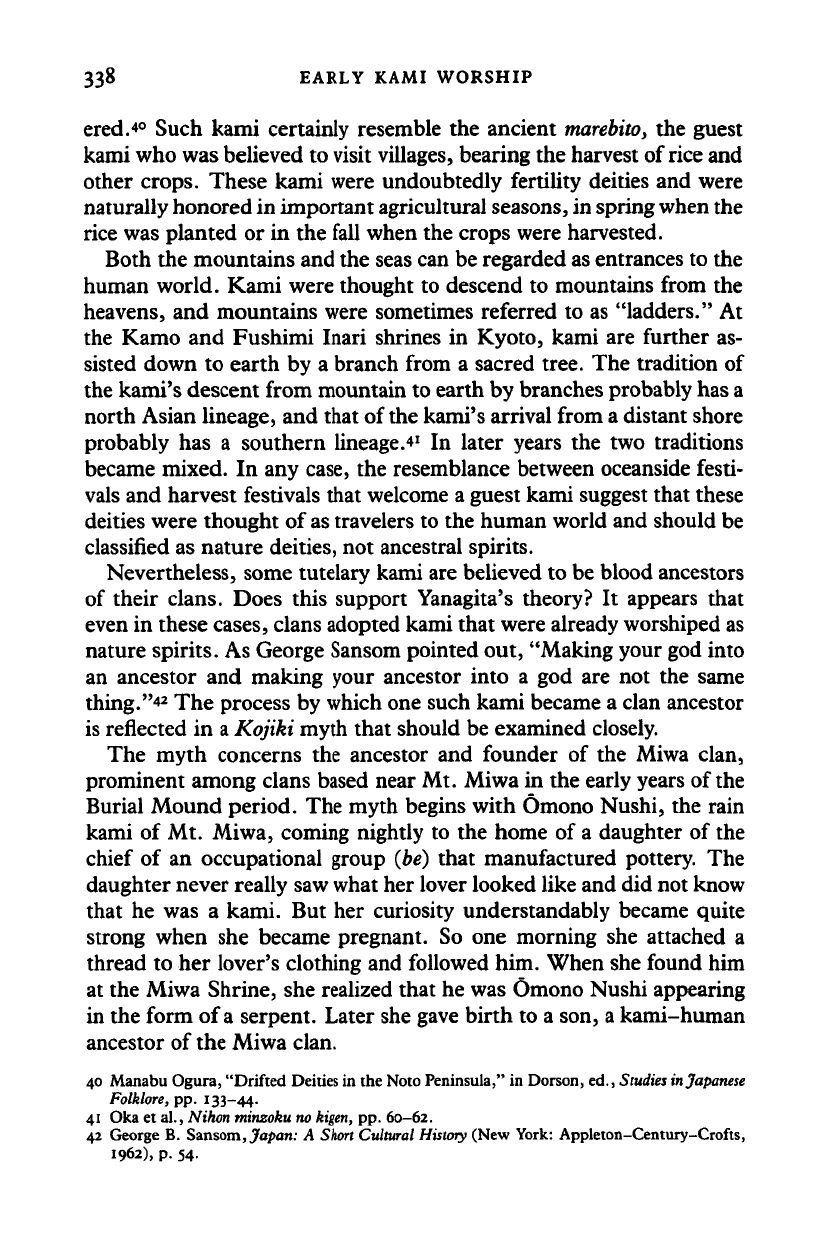
338 EARLY KAMI WORSHIP
ered.*
5
Such kami certainly resemble the ancient
marebito,
the guest
kami who was believed to visit villages, bearing the harvest of rice and
other crops. These kami were undoubtedly fertility deities and were
naturally honored in important agricultural
seasons,
in spring when the
rice was planted or in the fall when the crops were harvested.
Both the mountains and the seas can be regarded as entrances to the
human world. Kami were thought to descend to mountains from the
heavens, and mountains were sometimes referred to as "ladders." At
the Kamo and Fushimi Inari shrines in Kyoto, kami are further as-
sisted down to earth by a branch from a sacred tree. The tradition of
the kami's descent from mountain to earth by branches probably has a
north Asian lineage, and that of the kami's arrival from a distant shore
probably has a southern lineage.*
1
In later years the two traditions
became mixed. In any case, the resemblance between oceanside festi-
vals and harvest festivals that welcome a guest kami suggest that these
deities were thought of
as
travelers to the human world and should be
classified as nature deities, not ancestral spirits.
Nevertheless, some tutelary kami are believed to be blood ancestors
of their clans. Does this support Yanagita's theory? It appears that
even in these cases, clans adopted kami that were already worshiped as
nature spirits. As George Sansom pointed out, "Making your god into
an ancestor and making your ancestor into a god are not the same
thing."** The process by which one such kami became a clan ancestor
is reflected in
a
Kojiki myth that should be examined closely.
The myth concerns the ancestor and founder of the Miwa clan,
prominent among clans based near Mt. Miwa in the early years of the
Burial Mound period. The myth begins with Omono Nushi, the rain
kami of Mt. Miwa, coming nightly to the home of a daughter of the
chief of an occupational group (be) that manufactured pottery. The
daughter never really saw what her lover looked like and did not know
that he was a kami. But her curiosity understandably became quite
strong when she became pregnant. So one morning she attached a
thread to her lover's clothing and followed him. When she found him
at the Miwa Shrine, she realized that he was Omono Nushi appearing
in the form of a serpent. Later she gave birth to a son, a kami-human
ancestor of the Miwa clan.
40 Manabu Ogura, "Drifted Deities in the Noto Peninsula," in Dorson, ed., Studies in Japanese
Folklore, pp. 133-44.
41 Oka et al., Nihon minzoku no
kigen,
pp. 60—62.
42 George B. Sansom, Japan: A Short Cultural History (New York: Appleton-Century-Crofts,
1962),
p. 54.
Cambridge Histories Online © Cambridge University Press, 2008
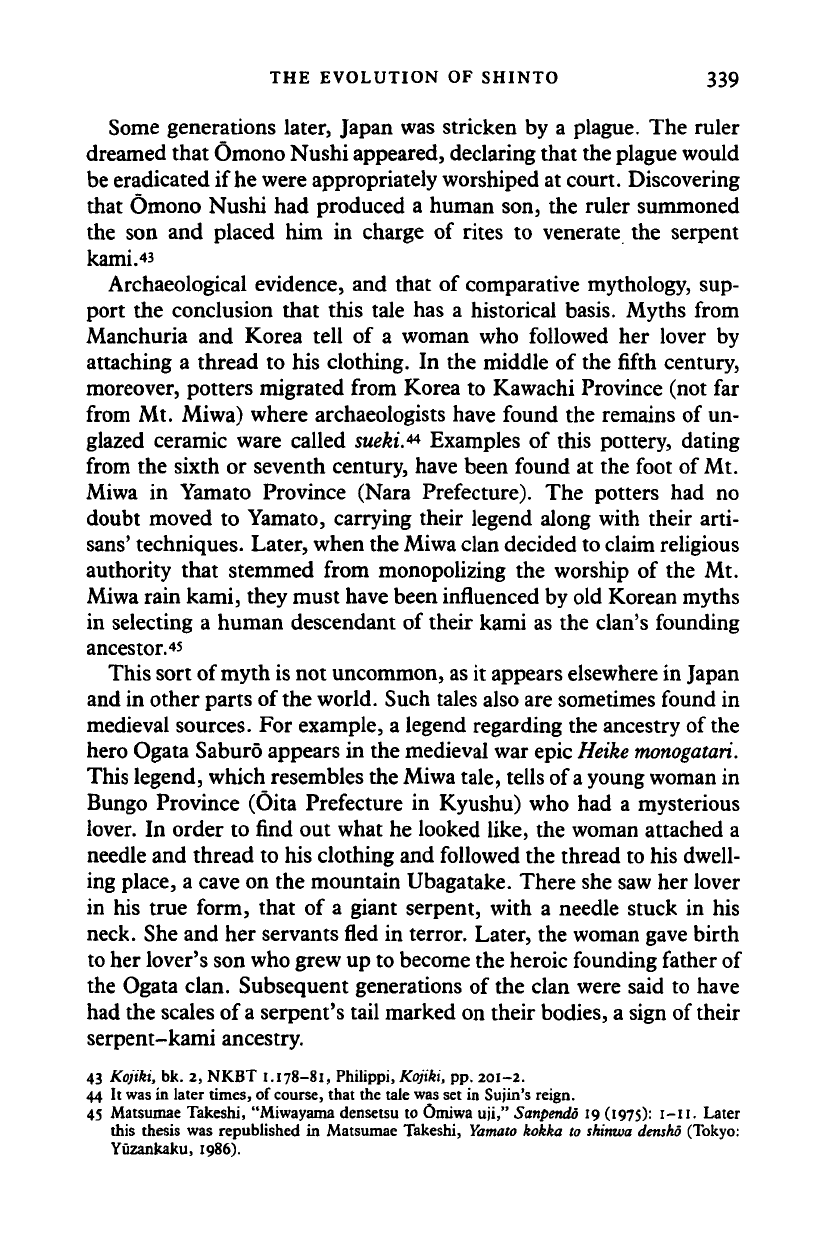
THE EVOLUTION OF SHINTO 339
Some generations later, Japan was stricken by a plague. The ruler
dreamed that Omono Nushi appeared, declaring that the plague would
be eradicated if he were appropriately worshiped at court. Discovering
that Omono Nushi had produced a human son, the ruler summoned
the son and placed him in charge of rites to venerate the serpent
kami.43
Archaeological evidence, and that of comparative mythology, sup-
port the conclusion that this tale has a historical basis. Myths from
Manchuria and Korea tell of a woman who followed her lover by
attaching a thread to his clothing. In the middle of the fifth century,
moreover, potters migrated from Korea to Kawachi Province (not far
from Mt. Miwa) where archaeologists have found the remains of un-
glazed ceramic ware called
sueki.
4
*
Examples of this pottery, dating
from the sixth or seventh century, have been found at the foot of Mt.
Miwa in Yamato Province (Nara Prefecture). The potters had no
doubt moved to Yamato, carrying their legend along with their arti-
sans'
techniques. Later, when the Miwa clan decided to claim religious
authority that stemmed from monopolizing the worship of the Mt.
Miwa rain kami, they must have been influenced by old Korean myths
in selecting a human descendant of their kami as the clan's founding
ancestor. 45
This sort of myth is not uncommon, as it appears elsewhere in Japan
and in other parts of the world. Such tales also are sometimes found in
medieval sources. For example, a legend regarding the ancestry of the
hero Ogata Saburo appears in the medieval war epic
Heike
monogatari.
This legend, which resembles the Miwa tale, tells of
a
young woman in
Bungo Province (Oita Prefecture in Kyushu) who had a mysterious
lover. In order to find out what he looked like, the woman attached a
needle and thread to his clothing and followed the thread to his dwell-
ing place, a cave on the mountain Ubagatake. There she saw her lover
in his true form, that of a giant serpent, with a needle stuck in his
neck. She and her servants fled in terror. Later, the woman gave birth
to her lover's son who grew up to become the heroic founding father of
the Ogata clan. Subsequent generations of the clan were said to have
had the scales of
a
serpent's tail marked on their bodies, a sign of their
serpent-kami ancestry.
43 Kojiki, bk. 2, NKBT 1.178-81, Philippi, Kojiki, pp. 201-2.
44 It was in later times, of course, that the tale was set in Sujin's reign.
45 Matsumae Takeshi, "Miwayama densetsu to Omiwa uji," Sanpendo 19 (197s):
1
—11.
Later
this thesis was republished in Matsumae Takeshi, Yamato kokka to shinwa
densho
(Tokyo:
Yuzankaku, 1986).
Cambridge Histories Online © Cambridge University Press, 2008
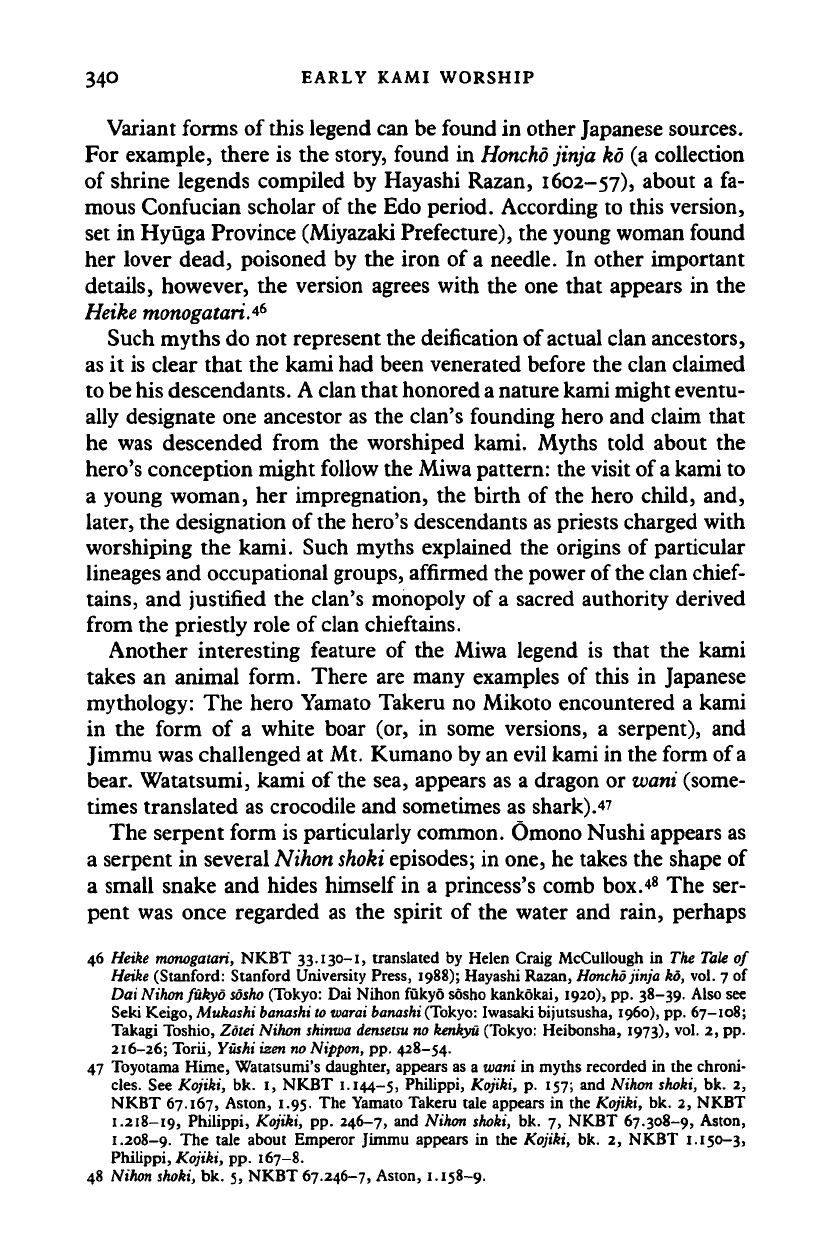
34° EARLY KAMI WORSHIP
Variant forms of this legend can be found in other Japanese sources.
For example, there is the story, found in
Honcho jinja
kd (a collection
of shrine legends compiled by Hayashi Razan, 1602-57), about a fa-
mous Confucian scholar of the Edo period. According to this version,
set in Hyuga Province (Miyazaki Prefecture), the young woman found
her lover dead, poisoned by the iron of a needle. In other important
details, however, the version agrees with the one that appears in the
Heike tnonogatariA
6
Such myths do not represent the deification of actual clan ancestors,
as it is clear that the kami had been venerated before the clan claimed
to be his descendants.
A
clan that honored
a
nature kami might eventu-
ally designate one ancestor as the clan's founding hero and claim that
he was descended from the worshiped kami. Myths told about the
hero's conception might follow the Miwa pattern: the visit of
a
kami to
a young woman, her impregnation, the birth of the hero child, and,
later, the designation of
the
hero's descendants as priests charged with
worshiping the kami. Such myths explained the origins of particular
lineages and occupational groups, affirmed the power of the clan
chief-
tains,
and justified the clan's monopoly of a sacred authority derived
from the priestly role of clan chieftains.
Another interesting feature of the Miwa legend is that the kami
takes an animal form. There are many examples of this in Japanese
mythology: The hero Yamato Takeru no Mikoto encountered a kami
in the form of a white boar (or, in some versions, a serpent), and
Jimmu was challenged at Mt. Kumano by an evil kami in the form of a
bear. Watatsumi, kami of the sea, appears as a dragon or
ward
(some-
times translated as crocodile and sometimes as shark).-»
7
The serpent form is particularly common. Omono Nushi appears as
a serpent in several Nihon
shoki
episodes; in one, he takes the shape of
a small snake and hides himself in a princess's comb box/
8
The ser-
pent was once regarded as the spirit of the water and rain, perhaps
46 Heike monogatari, NKBT 33.130-1, translated by Helen Craig McCullough in The Tale of
Heike (Stanford: Stanford University Press, 1988); Hayashi Razan, Honcho jinja kd, vol. 7 of
Dai Nihon fukyo
sosho
(Tokyo: Dai Nihon fukyo sosho kankokai, 1920), pp. 38-39. Also see
Seki Keigo, Mukashi banashi to warm
banashi
(Tokyo:
Iwasaki bijutsusha, i960), pp. 67-108;
Takagi Toshio, Zotei Nihon shinwa
densetsu
no kenkyu (Tokyo: Heibonsha, 1973), vol. 2, pp.
216-26; Torii, Yushi izen no Nippon, pp. 428-54.
47 Toyotama Hime, Watatsumi's daughter, appears as a viani in myths recorded in the chroni-
cles.
See Kojiki, bk. I, NKBT 1.144-5, Philippi, Kojiki, p. 157; and Nihon shoki, bk. 2,
NKBT 67.167, Aston, 1.95. The Yamato Takeru tale appears in the Kojiki, bk. 2, NKBT
1.218-19, Philippi, Kojiki, pp. 246-7, and Nihon shoki, bk. 7, NKBT 67.308-9, Aston,
1.208-9. The tale about Emperor Jimmu appears in the Kojiki, bk. 2, NKBT 1.150-3,
Philippi, Kojiki, pp. 167-8.
48 Nihon shoki, bk. 5, NKBT 67.246-7, Aston, 1.158-9.
Cambridge Histories Online © Cambridge University Press, 2008
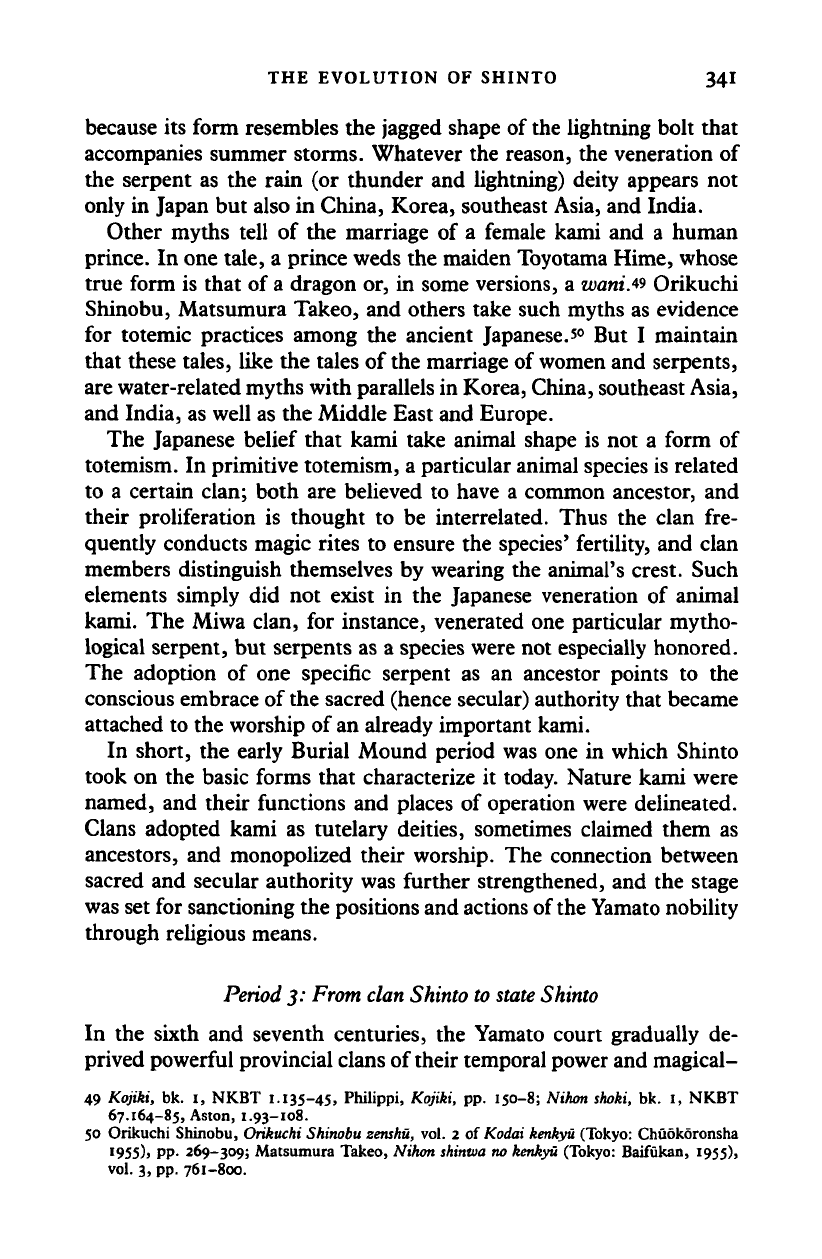
THE EVOLUTION OF SHINTO 34I
because its form resembles the jagged shape of the lightning bolt that
accompanies summer storms. Whatever the reason, the veneration of
the serpent as the rain (or thunder and lightning) deity appears not
only in Japan but also in China, Korea, southeast Asia, and India.
Other myths tell of the marriage of a female kami and a human
prince. In one tale, a prince weds the maiden Toyotama Hime, whose
true form is that of a dragon or, in some versions, a
wani.w
Orikuchi
Shinobu, Matsumura Takeo, and others take such myths as evidence
for totemic practices among the ancient Japanese.'
0
But I maintain
that these tales, like the tales of the marriage of women and serpents,
are water-related myths with parallels in Korea, China, southeast Asia,
and India, as well as the Middle East and Europe.
The Japanese belief that kami take animal shape is not a form of
totemism. In primitive totemism, a particular animal species is related
to a certain clan; both are believed to have a common ancestor, and
their proliferation is thought to be interrelated. Thus the clan fre-
quently conducts magic rites to ensure the species' fertility, and clan
members distinguish themselves by wearing the animal's crest. Such
elements simply did not exist in the Japanese veneration of animal
kami. The Miwa clan, for instance, venerated one particular mytho-
logical serpent, but serpents as a species were not especially honored.
The adoption of one specific serpent as an ancestor points to the
conscious embrace of the sacred (hence secular) authority that became
attached to the worship of an already important kami.
In short, the early Burial Mound period was one in which Shinto
took on the basic forms that characterize it today. Nature kami were
named, and their functions and places of operation were delineated.
Clans adopted kami as tutelary deities, sometimes claimed them as
ancestors, and monopolized their worship. The connection between
sacred and secular authority was further strengthened, and the stage
was set for sanctioning the positions and actions of the Yamato nobility
through religious means.
Period 3: Front clan Shinto to
state
Shinto
In the sixth and seventh centuries, the Yamato court gradually de-
prived powerful provincial clans of their temporal power and magical-
49 Kojiki, bk. i, NKBT 1.135-45, Philippi, Kojiki, pp. 150-8; Nihon shoki, bk. 1, NKBT
67.164-85, Aston, 1.93-108.
50 Orikuchi Shinobu, Orikuchi Shinobu zenshu, vol. 2 of Kodai kenkyu (Tokyo: Chuokoronsha
1955)) PP- 269-309; Matsumura Takeo, Nihon shintva no kenkyu (Tokyo: Baifukan, 1955),
vol. 3, pp. 761-800.
Cambridge Histories Online © Cambridge University Press, 2008
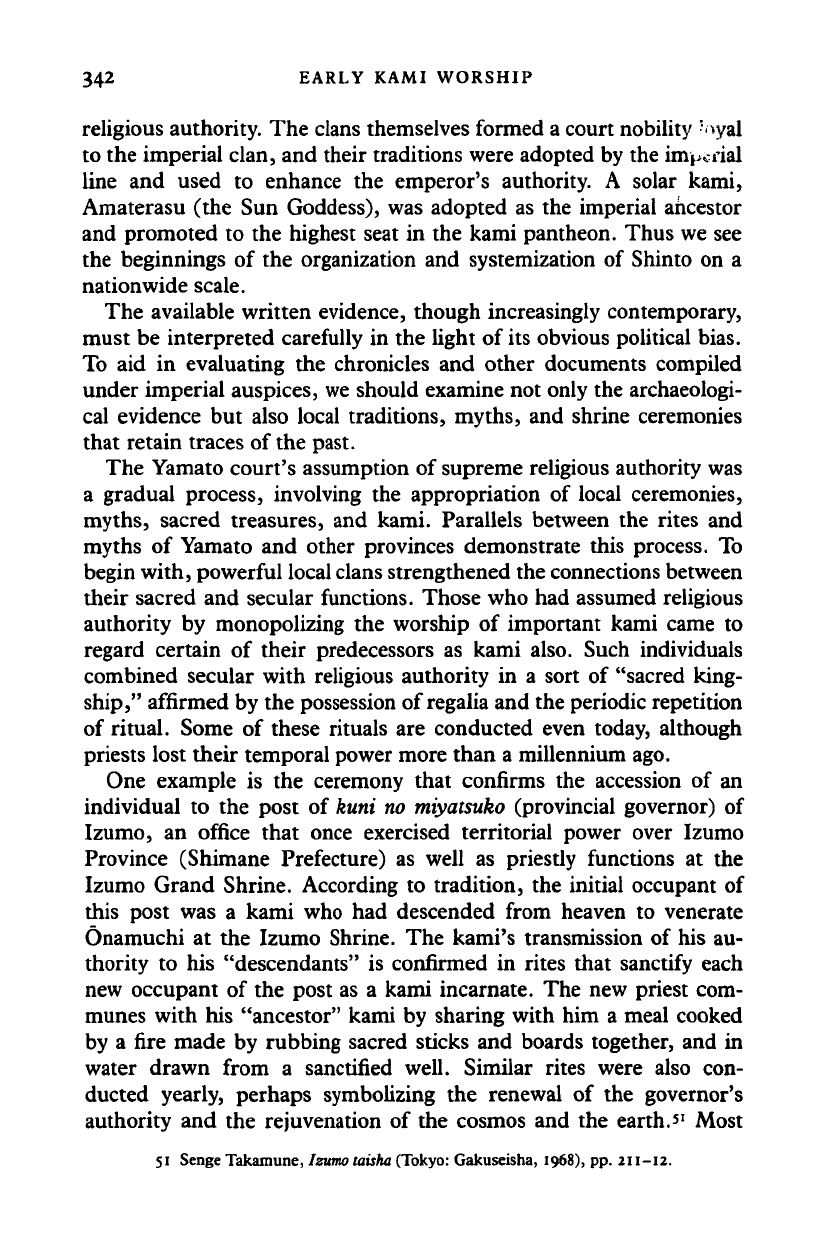
342 EARLY KAMI WORSHIP
religious authority. The clans themselves formed a court nobility '>>yal
to the imperial clan, and their traditions were adopted by the imperial
line and used to enhance the emperor's authority. A solar kami,
Amaterasu (the Sun Goddess), was adopted as the imperial ancestor
and promoted to the highest seat in the kami pantheon. Thus we see
the beginnings of the organization and systemization of Shinto on a
nationwide scale.
The available written evidence, though increasingly contemporary,
must be interpreted carefully in the light of its obvious political bias.
To aid in evaluating the chronicles and other documents compiled
under imperial auspices, we should examine not only the archaeologi-
cal evidence but also local traditions, myths, and shrine ceremonies
that retain traces of the past.
The Yamato court's assumption of supreme religious authority was
a gradual process, involving the appropriation of local ceremonies,
myths, sacred treasures, and kami. Parallels between the rites and
myths of Yamato and other provinces demonstrate this process. To
begin with, powerful local clans strengthened the connections between
their sacred and secular functions. Those who had assumed religious
authority by monopolizing the worship of important kami came to
regard certain of their predecessors as kami also. Such individuals
combined secular with religious authority in a sort of "sacred king-
ship,"
affirmed by the possession of regalia and the periodic repetition
of ritual. Some of these rituals are conducted even today, although
priests lost their temporal power more than a millennium ago.
One example is the ceremony that confirms the accession of an
individual to the post of kuni no
miyatsuko
(provincial governor) of
Izumo, an office that once exercised territorial power over Izumo
Province (Shimane Prefecture) as well as priestly functions at the
Izumo Grand Shrine. According to tradition, the initial occupant of
this post was a kami who had descended from heaven to venerate
Onamuchi at the Izumo Shrine. The kami's transmission of his au-
thority to his "descendants" is confirmed in rites that sanctify each
new occupant of the post as a kami incarnate. The new priest com-
munes with his "ancestor" kami by sharing with him a meal cooked
by a fire made by rubbing sacred sticks and boards together, and in
water drawn from a sanctified well. Similar rites were also con-
ducted yearly, perhaps symbolizing the renewal of the governor's
authority and the rejuvenation of the cosmos and the earth.
51
Most
51 Senge Takamune, Izumo taisha (Tokyo: Gakuseisha, 1968), pp. 211-12.
Cambridge Histories Online © Cambridge University Press, 2008
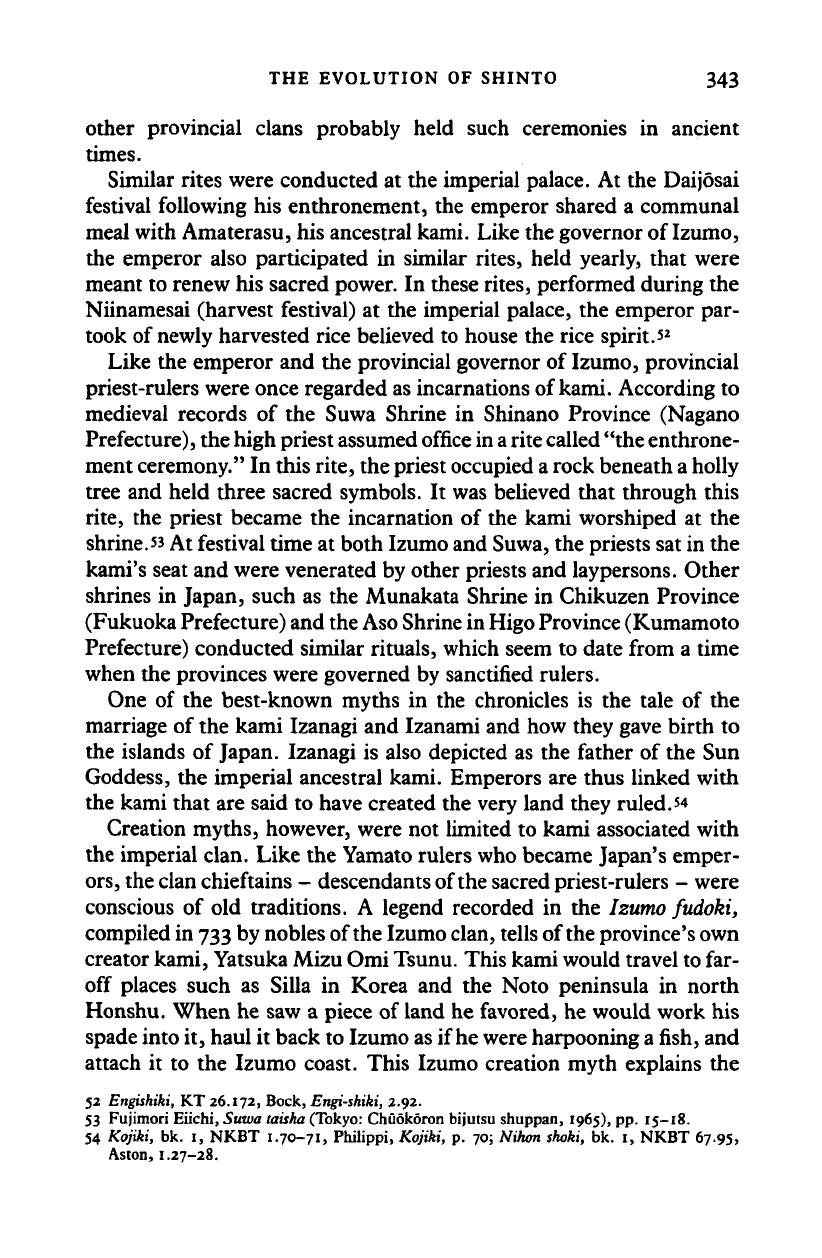
THE EVOLUTION
OF
SHINTO
343
other provincial clans probably held such ceremonies
in
ancient
times.
Similar rites were conducted
at the
imperial palace.
At the
Daijosai
festival following
his
enthronement,
the
emperor shared
a
communal
meal with Amaterasu,
his
ancestral kami. Like the governor
of
Izumo,
the emperor also participated
in
similar rites, held yearly, that were
meant
to
renew
his
sacred power.
In
these rites, performed during
the
Niinamesai (harvest festival)
at the
imperial palace,
the
emperor
par-
took
of
newly harvested rice believed
to
house
the
rice spirit.
52
Like
the
emperor
and the
provincial governor
of
Izumo, provincial
priest-rulers were once regarded as incarnations of kami. According
to
medieval records
of the
Suwa Shrine
in
Shinano Province (Nagano
Prefecture), the high priest assumed office
in a
rite called "the enthrone-
ment ceremony."
In
this rite, the priest occupied
a
rock beneath
a
holly
tree
and
held three sacred symbols.
It
was believed that through this
rite,
the
priest became
the
incarnation
of the
kami worshiped
at the
shrine.53
At festival time
at
both Izumo and Suwa, the priests
sat in the
kami's seat
and
were venerated
by
other priests
and
laypersons. Other
shrines
in
Japan, such
as the
Munakata Shrine
in
Chikuzen Province
(Fukuoka Prefecture) and the
Aso
Shrine in
Higo
Province (Kumamoto
Prefecture) conducted similar rituals, which seem
to
date from
a
time
when
the
provinces were governed
by
sanctified rulers.
One
of the
best-known myths
in the
chronicles
is the
tale
of the
marriage
of
the kami Izanagi
and
Izanami
and how
they gave birth
to
the islands
of
Japan. Izanagi
is
also depicted
as the
father
of the Sun
Goddess,
the
imperial ancestral kami. Emperors
are
thus linked with
the kami that
are
said
to
have created
the
very land they ruled.5*
Creation myths, however, were
not
limited
to
kami associated with
the imperial clan. Like
the
Yamato rulers who became Japan's emper-
ors,
the clan chieftains
-
descendants of the sacred priest-rulers
-
were
conscious
of old
traditions.
A
legend recorded
in the
Izumo fudoki,
compiled in
733
by nobles of the Izumo
clan,
tells of the province's own
creator kami, Yatsuka Mizu Omi Tsunu. This kami would travel to
far-
off places such
as
Silla
in
Korea
and the
Noto peninsula
in
north
Honshu. When
he saw a
piece
of
land
he
favored,
he
would work
his
spade into
it,
haul
it
back
to
Izumo as if he were harpooning
a
fish,
and
attach
it to the
Izumo coast. This Izumo creation myth explains
the
52 Engishiki, KT 26.172, Bock, Engi-shiki, 2.92.
53 Fujimori Eiichi, Suwa
taisha
(Tokyo: Chuokoron bijutsu shuppan, 1965), pp. 15-18.
54 Kojiki, bk. 1, NKBT 1.70-71, Philippi, Kojiki, p. 70; Nihon shoki, bk. 1, NKBT 67.95,
Aston,
1.27-28.
Cambridge Histories Online © Cambridge University Press, 2008
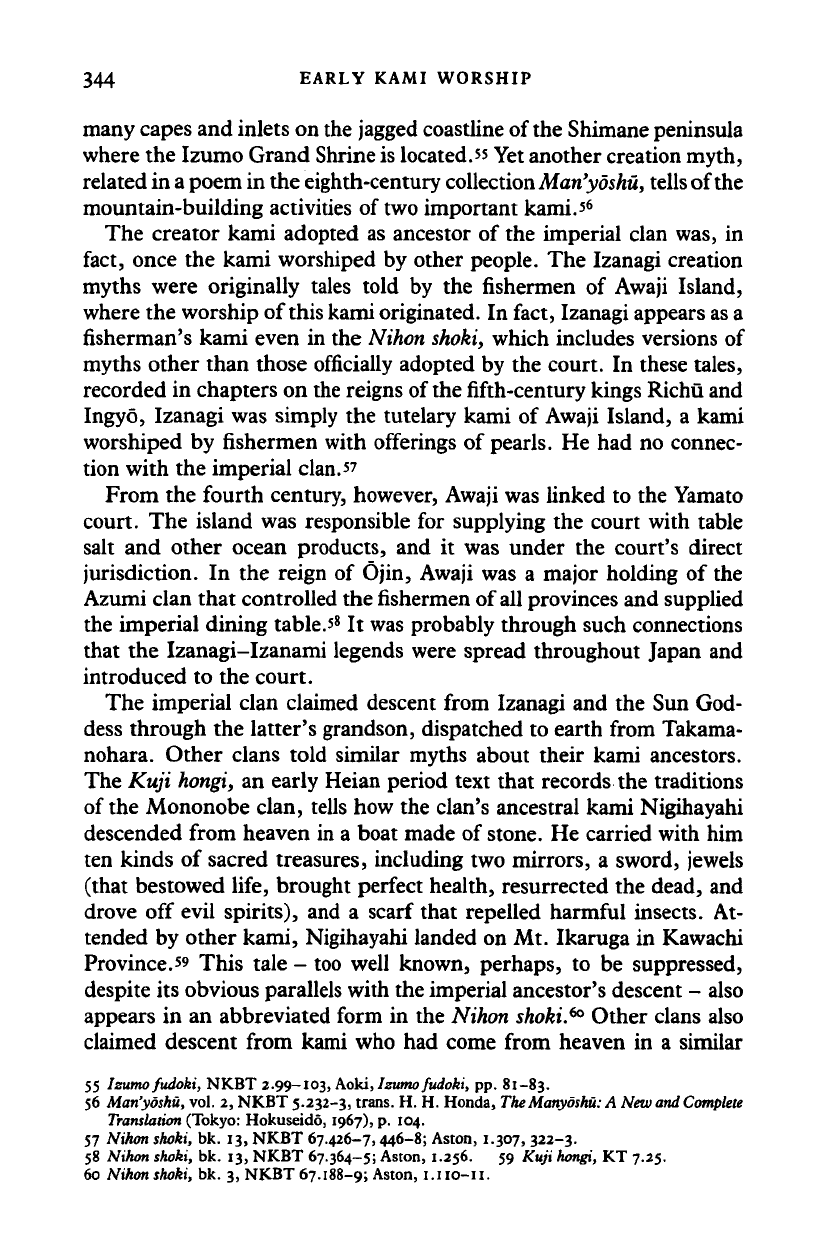
344 EARLY KAMI WORSHIP
many capes and inlets on the jagged coastline of the Shimane peninsula
where the Izumo Grand Shrine is located.55 Yet another creation myth,
related in
a
poem in the eighth-century collection
Man'yoshu,
tells
of the
mountain-building activities of two important kami.*
6
The creator kami adopted as ancestor of the imperial clan was, in
fact, once the kami worshiped by other people. The Izanagi creation
myths were originally tales told by the fishermen of Awaji Island,
where the worship of this kami originated. In fact, Izanagi appears
as
a
fisherman's kami even in the Nihon
shoki,
which includes versions of
myths other than those officially adopted by the court. In these tales,
recorded in chapters on the reigns of the fifth-century kings Richu and
Ingyo, Izanagi was simply the tutelary kami of Awaji Island, a kami
worshiped by fishermen with offerings of pearls. He had no connec-
tion with the imperial clan."
From the fourth century, however, Awaji was linked to the Yamato
court. The island was responsible for supplying the court with table
salt and other ocean products, and it was under the court's direct
jurisdiction. In the reign of Ojin, Awaji was a major holding of the
Azumi clan that controlled the fishermen of all provinces and supplied
the imperial dining table.*
8
It was probably through such connections
that the Izanagi-Izanami legends were spread throughout Japan and
introduced to the court.
The imperial clan claimed descent from Izanagi and the Sun God-
dess through the latter's grandson, dispatched to earth from Takama-
nohara. Other clans told similar myths about their kami ancestors.
The Kuji
hongi,
an early Heian period text that records the traditions
of the Mononobe clan, tells how the clan's ancestral kami Nigihayahi
descended from heaven in a boat made of
stone.
He carried with him
ten kinds of sacred treasures, including two mirrors, a sword, jewels
(that bestowed life, brought perfect health, resurrected the dead, and
drove off evil spirits), and a scarf that repelled harmful insects. At-
tended by other kami, Nigihayahi landed on Mt. Ikaruga in Kawachi
Province.
59
This tale - too well known, perhaps, to be suppressed,
despite its obvious parallels with the imperial ancestor's descent - also
appears in an abbreviated form in the Nihon shoki.
60
Other clans also
claimed descent from kami who had come from heaven in a similar
55 Izumo fudoki, NKBT 2.99-103, Aoki, Izumo fudoki, pp. 81-83.
56 Man'yoshu, vol. 2, NKBT 5.232-3, trans. H. H. Honda,
The
Manyoshu:
A New and
Complete
Translation
(Tokyo: Hokuseido, 1967), p. 104.
57 Nihon shoki, bk. 13, NKBT 67.426-7,446-8; Aston, 1.307, 322-3.
58 Nihon shoki, bk. 13, NKBT 67.364-5; Aston, 1.256. 59 Kuji
hongi,
KT 7.25.
60 Nihon shoki, bk. 3, NKBT 67.188-9; Aston, i.no-u.
Cambridge Histories Online © Cambridge University Press, 2008
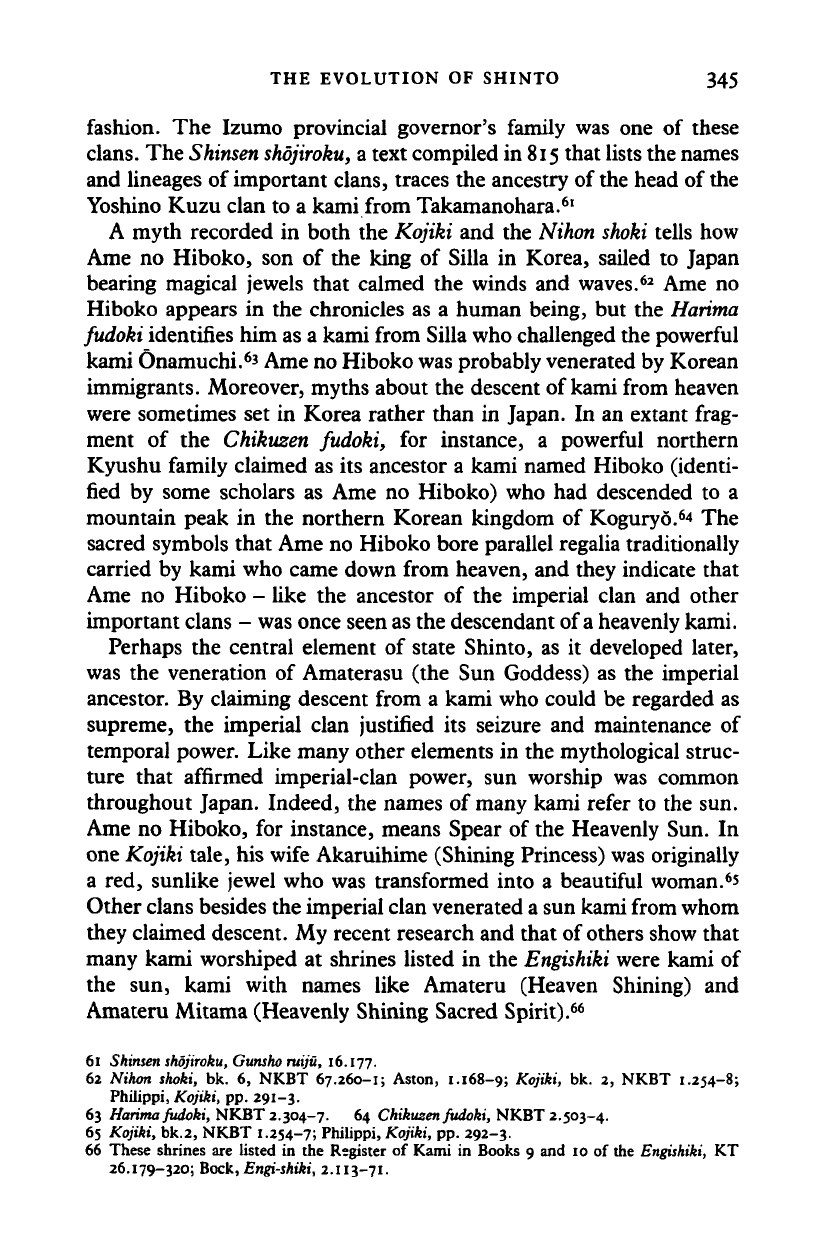
THE EVOLUTION OF SHINTO 345
fashion. The Izumo provincial governor's family was one of these
clans.
The
Shinsen
shojiroku,
a text compiled in
815
that lists the names
and lineages of important clans, traces the ancestry of the head of the
Yoshino Kuzu clan to a kami from Takamanohara.
61
A myth recorded in both the Kojiki and the Nihon skoki tells how
Ame no Hiboko, son of the king of Silla in Korea, sailed to Japan
bearing magical jewels that calmed the winds and waves.
62
Ame no
Hiboko appears in the chronicles as a human being, but the
Harima
fudoki identifies him as a kami from Silla who challenged the powerful
kami Onamuchi.
63
Ame no Hiboko was probably venerated by Korean
immigrants. Moreover, myths about the descent of kami from heaven
were sometimes set in Korea rather than in Japan. In an extant frag-
ment of the Chikuzen fudoki, for instance, a powerful northern
Kyushu family claimed as its ancestor a kami named Hiboko (identi-
fied by some scholars as Ame no Hiboko) who had descended to a
mountain peak in the northern Korean kingdom of Koguryo.
6
* The
sacred symbols that Ame no Hiboko bore parallel regalia traditionally
carried by kami who came down from heaven, and they indicate that
Ame no Hiboko - like the ancestor of the imperial clan and other
important clans - was once seen as the descendant of a heavenly kami.
Perhaps the central element of state Shinto, as it developed later,
was the veneration of Amaterasu (the Sun Goddess) as the imperial
ancestor. By claiming descent from a kami who could be regarded as
supreme, the imperial clan justified its seizure and maintenance of
temporal power. Like many other elements in the mythological struc-
ture that affirmed imperial-clan power, sun worship was common
throughout Japan. Indeed, the names of many kami refer to the sun.
Ame no Hiboko, for instance, means Spear of the Heavenly Sun. In
one Kojiki tale, his wife Akaruihime (Shining Princess) was originally
a red, sunlike jewel who was transformed into a beautiful woman.
65
Other clans besides the imperial clan venerated a sun kami from whom
they claimed descent. My recent research and that of others show that
many kami worshiped at shrines listed in the
Engishiki
were kami of
the sun, kami with names like Amateru (Heaven Shining) and
Amateru Mitama (Heavenly Shining Sacred Spirit).
66
61
Shinsen
shojiroku,
Gunsho
ruiju, 16.177.
62 Nihon shoki, bk. 6, NKBT 67.260-1; Aston, 1.168-9; Kojiki, bk. 2, NKBT 1.254-8;
Philippi, Kojiki, pp. 291-3.
63
Harima
fudoki, NKBT 2.304-7. 64
Chikuzen
fudoki, NKBT 2.503-4.
65 Kojiki, bk.2, NKBT 1.254-7; Philippi, Kojiki, pp. 292-3.
66 These shrines are listed in the Register of Kami in Books 9 and 10 of the Engishiki, KT
26.179-320; Bock, Engishiki, 2.113-71.
Cambridge Histories Online © Cambridge University Press, 2008
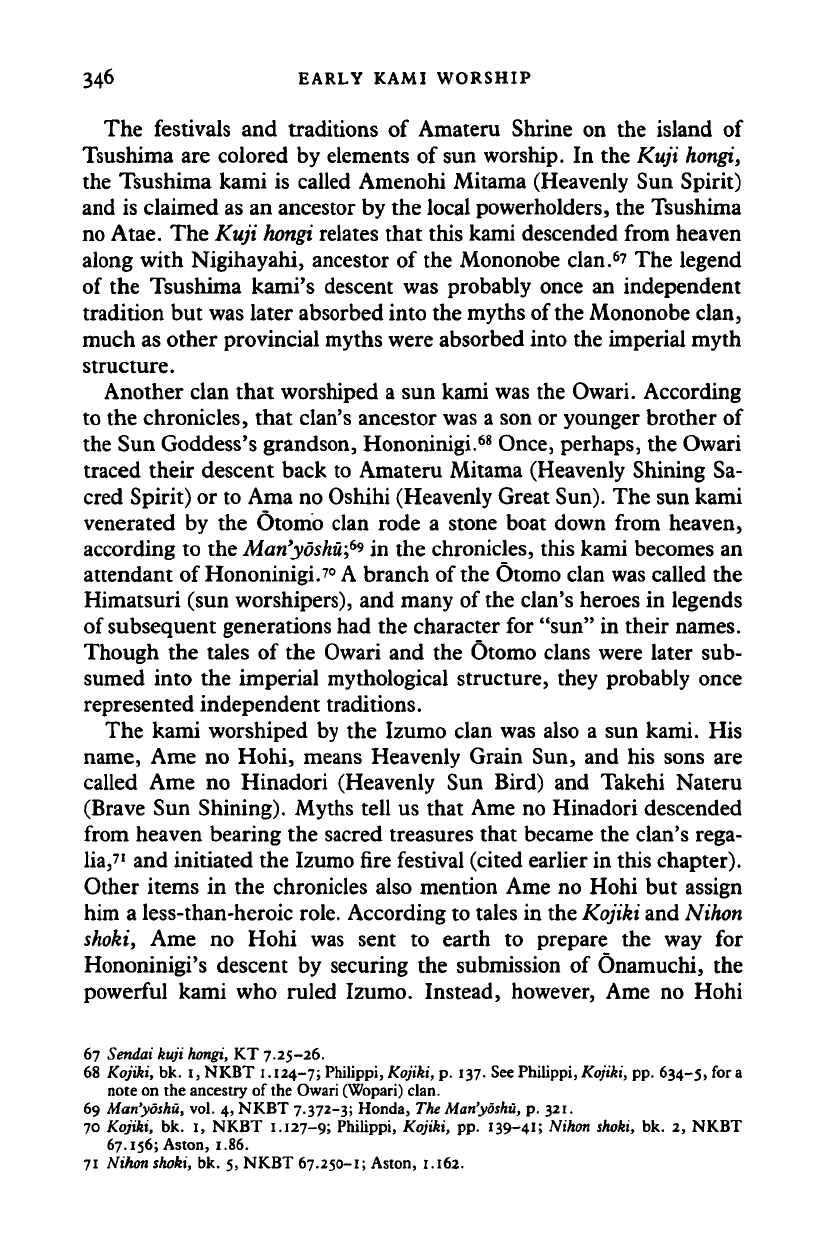
346 EARLY KAMI WORSHIP
The festivals and traditions of Amateru Shrine on the island of
Tsushima are colored by elements of sun worship. In the Kuji hongi,
the Tsushima kami is called Amenohi Mitama (Heavenly Sun Spirit)
and is claimed as an ancestor by the local powerholders, the Tsushima
no Atae. The Kuji
hongi
relates that this kami descended from heaven
along with Nigihayahi, ancestor of the Mononobe clan.
6
? The legend
of the Tsushima kami's descent was probably once an independent
tradition but was later absorbed into the myths of the Mononobe clan,
much as other provincial myths were absorbed into the imperial myth
structure.
Another clan that worshiped a sun kami was the Owari. According
to the chronicles, that clan's ancestor was a son or younger brother of
the Sun Goddess's grandson, Hononinigi.
68
Once, perhaps, the Owari
traced their descent back to Amateru Mitama (Heavenly Shining Sa-
cred Spirit) or to Ama no Oshihi (Heavenly Great Sun). The sun kami
venerated by the Otomo clan rode a stone boat down from heaven,
according to the
Man'yoshu;
69
in the chronicles, this kami becomes an
attendant of Hononinigi.7°
A
branch of the Otomo clan was called the
Himatsuri (sun worshipers), and many of the clan's heroes in legends
of subsequent generations had the character for "sun" in their names.
Though the tales of the Owari and the Otomo clans were later sub-
sumed into the imperial mythological structure, they probably once
represented independent traditions.
The kami worshiped by the Izumo clan was also a sun kami. His
name, Ame no Hohi, means Heavenly Grain Sun, and his sons are
called Ame no Hinadori (Heavenly Sun Bird) and Takehi Nateru
(Brave Sun Shining). Myths tell us that Ame no Hinadori descended
from heaven bearing the sacred treasures that became the clan's rega-
lia,
71
and initiated the Izumo fire festival (cited earlier in this chapter).
Other items in the chronicles also mention Ame no Hohi but assign
him a less-than-heroic role. According to tales in the Kojiki and Nihon
shoki, Ame no Hohi was sent to earth to prepare the way for
Hononinigi's descent by securing the submission of Onamuchi, the
powerful kami who ruled Izumo. Instead, however, Ame no Hohi
67
Sendai
kuji
hongi,
KT 7.25-26.
68 Kojiki, bk. I, NKBT
1.124-7;
Philippi,Kojiki, p. 137. SeePhilippi,Kojiki, pp. 634-5, fora
note on the ancestry of the Owari (Wopari) clan.
69
Man'yoshu,
vol. 4, NKBT 7.372-3; Honda,
The
Man'yoshu,
p. 321.
70 Kojiki, bk. 1, NKBT
1.127-9;
Philippi, Kojiki, pp.
139-41;
Nihon
shoki,
bk. 2, NKBT
67.156;
Aston, 1.86.
71
Nihon
shoki,
bk. 5, NKBT
67.250-1;
Aston,
1.162.
Cambridge Histories Online © Cambridge University Press, 2008
